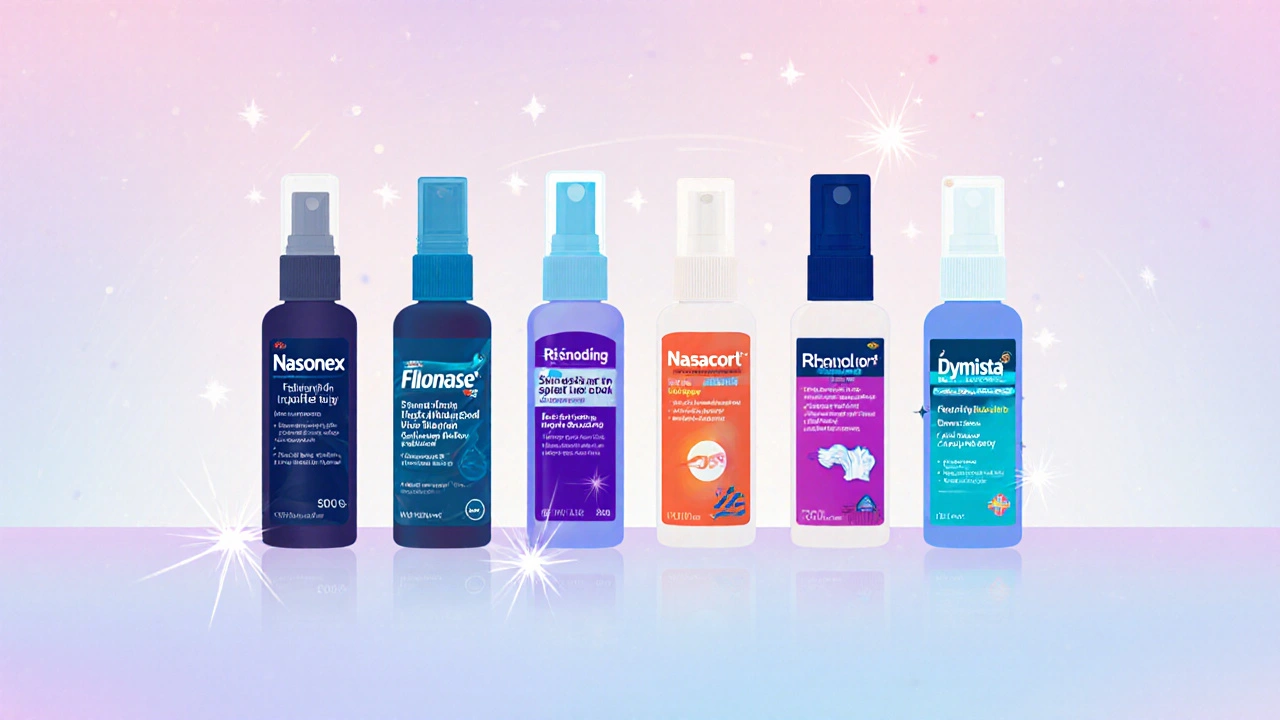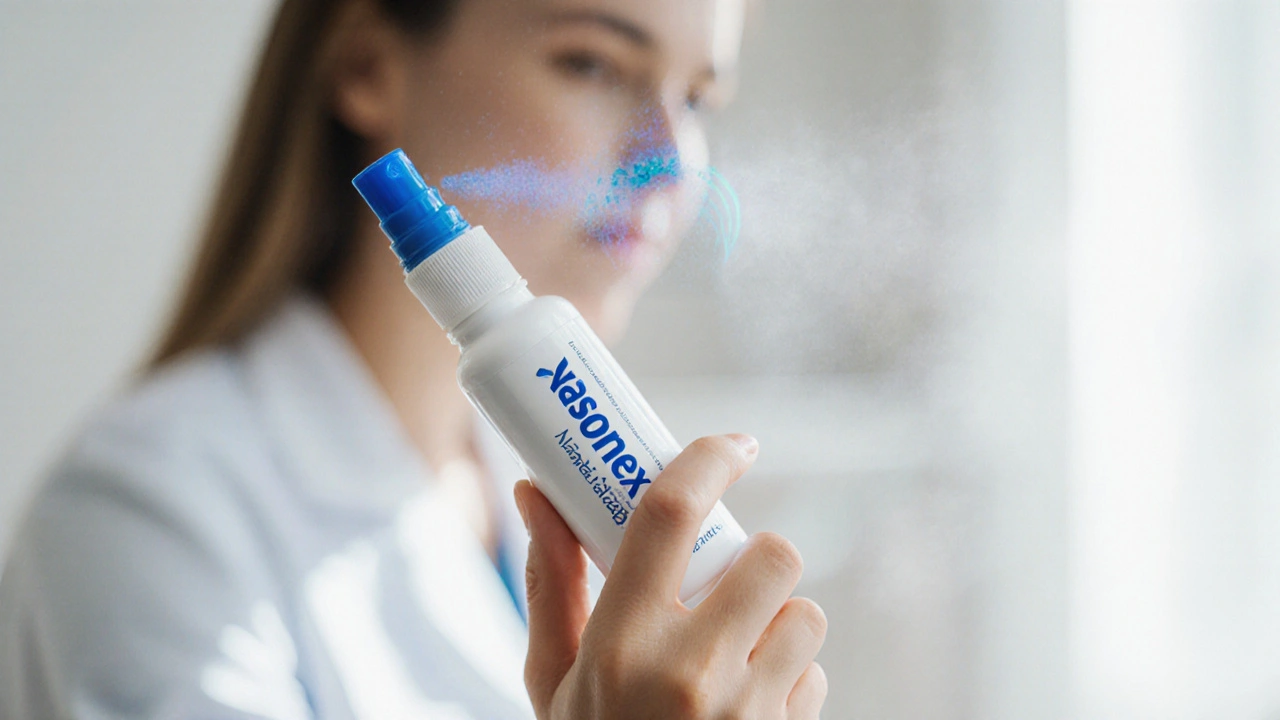Nasal Spray Recommendation Tool
Find Your Best Spray
Quick Summary
- Nasonex contains mometasone furoate, one of the strongest OTC‑available corticosteroids for nasal inflammation.
- Flonase (fluticasone propionate) and Rhinocort (budesonide) are slightly less potent but cheaper and available without prescription.
- Nasacort (triamcinolone acetonide) works well for mild to moderate symptoms and has a gentle taste.
- Dymista combines azelastine antihistamine with fluticasone for fast relief and added anti‑allergy action.
- Choose based on prescription need, price, onset speed, and any specific sensitivities you have.
When you reach for a nasal spray, Nasonex is a prescription‑only spray that contains mometasone furoate, a potent corticosteroid designed to shrink swollen nasal tissue and curb allergy inflammation. Since its launch in the late 1990s, it’s become a staple for people with chronic allergic rhinitis, nasal polyps, or seasonal hay fever.
But you’re not limited to one brand. The market is crowded with options that differ in active ingredient, strength, cost, and whether you need a prescription. This guide breaks down the most common alternatives, lines up the key factors you should weigh, and helps you spot the spray that fits your lifestyle.
How Nasal Steroid Sprays Work
All of the sprays we’ll discuss belong to the corticosteroid family. They act by binding to glucocorticoid receptors in the nasal lining, which tells immune cells to dial down histamine release and mucus production. The result? Less congestion, itching, and sneezing.
Because the medication is delivered directly to the nose, you get high local effect with minimal systemic absorption. That’s why even high‑potency steroids like mometasone are considered safe for long‑term use when you follow the recommended dosage.
Key Comparison Criteria
- Active ingredient & potency - Determines how quickly symptoms subside and how severe the condition can be treated.
- Prescription status - Affects cost, insurance coverage, and ease of acquisition.
- Onset of action - How many days before you feel relief.
- Price per spray - Important if you need daily use for months.
- Side‑effect profile - Includes risk of nosebleeds, throat irritation, or rare systemic effects.
- Special features - Combination antihistamine, kids‑friendly formulations, or preservative‑free options.

Top Alternatives to Nasonex
Below are the most widely available nasal corticosteroids in the United States, Canada, Australia, and the UK.
Flonase (fluticasone propionate) is an over‑the‑counter spray that offers a slightly lower potency than mometasone but works for most seasonal allergies. It usually shows noticeable improvement after 3‑5 days.
Rhinocort (budesonide) is another OTC option. Budesonide has a reputation for being gentle on the nasal lining, making it a good pick if you’ve experienced frequent nosebleeds with stronger steroids.
Nasacort (triamcinolone acetonide) is marketed as “non‑prescription” in many regions. It’s effective for mild‑to‑moderate symptoms and often praised for its mild taste.
Dymista combines azelastine hydrochloride (an antihistamine) with fluticasone propionate. This dual‑action formula delivers both anti‑inflammatory and antihistamine benefits, cutting symptom onset to 30‑45 minutes for many users.
Beclomethasone dipropionate (often sold as Beclovent) is a prescription spray more common in Europe and Australia. It sits between mometasone and fluticasone in potency.
Side‑by‑Side Comparison
| Feature | Nasonex (Mometasone Furoate) | Flonase (Fluticasone Propionate) | Rhinocort (Budesonide) | Nasacort (Triamcinolone Acetonide) | Dymista (Azelastine + Fluticasone) |
|---|---|---|---|---|---|
| Prescription? | Yes | No | No | No | Yes (combo prescription) |
| Potency (relative) | High | Moderate‑High | Moderate | Low‑Moderate | High (dual‑action) |
| Typical Onset | 2‑3 days | 3‑5 days | 4‑6 days | 5‑7 days | 30‑45 mins |
| Price per 30‑spray bottle (USD) | $25‑$35 (generic) | $12‑$18 | $14‑$20 | $10‑$15 | $45‑$55 |
| Common Side‑Effects | Nosebleed, throat irritation | Throat irritation, mild taste | Nose dryness, occasional cough | Mild taste, rare nosebleed | Nosebleed, drowsiness (azelastine) |
| Kids‑Friendly? | Yes (2y+ with pediatric dose) | Yes (4y+) | Yes (6y+) | Yes (2y+) | Yes (6y+) |
Best‑Fit Scenarios
When Nasonex shines: You have moderate‑to‑severe year‑round allergic rhinitis, need a prescription for insurance coverage, or have tried OTC sprays without full relief. Its high potency often clears stubborn nasal polyps when used under a doctor’s guidance.
Flonase is the go‑to for seasonal allergies that flare up for a few weeks each year. Its OTC status means you can pick it up at the pharmacy without a visit.
If you’re prone to nosebleeds, Rhinocort’s gentler formula may be kinder on delicate nasal vessels.
Nasacort works well for children who dislike the stronger taste of other sprays and for those with mild symptoms that don’t merit a prescription.
Dymista is ideal when you want ultra‑fast relief and don’t mind a combo product. The antihistamine component tackles histamine‑driven itching while the steroid reduces swelling.

How to Choose the Right Spray
- Assess symptom severity. Mild seasonal sneezing? Try an OTC like Flonase or Nasacort. Persistent congestion? Consider Nasonex or Dymista.
- Check insurance coverage. Prescription sprays may be partially reimbursed, making them cheaper than they appear.
- Evaluate cost per dose. Divide the price by the number of recommended sprays (usually 2 per nostril per day) to see the real cost.
- Look for special needs. Kids, pregnancy, or a history of nosebleeds may steer you toward a milder or preservative‑free option.
- Trial period. Many pharmacies let you return unused spray within 30days. Use that window to test comfort and effectiveness.
Tips, Pitfalls, and Pro‑Tactics
- Always prime the spray before the first use - a few quick pumps into the air clears the nozzle.
- Aim the nozzle slightly outward, not straight up, to avoid dripping down the throat.
- Blow your nose gently 5minutes after each dose to keep the medication in the nasal cavity.
- If you experience frequent nosebleeds, try a saline rinse before the steroid spray to moisturize the lining.
- Do not exceed the recommended dose; higher use doesn’t mean faster relief and can increase side‑effects.
Frequently Asked Questions
Can I use Nasonex and an OTC spray together?
Usually you don’t need both. If a doctor prescribes Nasonex, they’ve accounted for its potency. Using two steroids can increase the risk of side‑effects. Talk to your physician if you think you need extra relief.
How long does it take for Nasonex to start working?
Most users notice improvement within 2‑3days, but full effect may take up to two weeks of regular use.
Is it safe to use Nasonex during pregnancy?
Mometasone is classified as CategoryC by the FDA, meaning risk cannot be ruled out. Discuss with your obstetrician before starting any nasal steroid.
What’s the biggest difference between Flonase and Rhinocort?
Flonase’s active ingredient, fluticasone, is slightly more potent, while Rhinocort’s budesonide is gentler on the nasal lining, making it a better choice for people prone to dryness or bleeding.
Can I switch from Nasonex to an OTC spray?
Yes, but taper down gradually to avoid rebound congestion. Start with half the usual OTC dose for a week, then adjust as needed.
Choosing the right nasal spray hinges on how severe your symptoms are, whether you need a prescription, and how much you’re willing to spend. Nasonex nasal spray remains a top pick for heavy‑duty relief, but the alternatives listed here cover every budget and comfort level. Test a few, track your symptom score, and stick with the one that keeps you breathing easy.

Matt Quirie
October 14, 2025 AT 20:57In reviewing the comparative data, one observes that Nasonex possesses a markedly higher corticosteroid potency; consequently, its therapeutic onset is accelerated relative to many over‑the‑counter options. Moreover, the prescription status introduces an insurance‑coverage variable that may offset the apparent cost differential. Patients with chronic rhinitis frequently report superior symptom resolution when adhering to the recommended dosing schedule. It remains advisable to consult a healthcare professional prior to initiating therapy.
Pat Davis
October 15, 2025 AT 05:17The table delineates a clear hierarchy of efficacy, wherein the combination formulation offers rapid relief but at a premium price point. While Flonase provides an accessible entry‑level option, its slower onset may be suboptimal for severe sufferers. In contrast, Rhinocort’s gentler profile serves those with mucosal sensitivity. Ultimately, individual clinical presentation should dictate selection.
Mary Wrobel
October 15, 2025 AT 13:37Picture this: you’re battling a relentless sneeze storm, and you reach for a spray that feels like a tropical breeze rather than a chemical assault. Nasacort’s mild taste and kid‑friendly design make it a champion for families, whereas Dymista’s dual‑action packs a punch faster than a lightning strike. Each product paints its own vivid hue on the allergy‑relief palette.
Kristie Barnes
October 15, 2025 AT 21:57Got a quick tip: always prime the nozzle before the first use.
Michelle Guatato
October 16, 2025 AT 06:17It is no coincidence that the most powerful nasal steroids are locked behind a prescription; the pharma giants profit from the gatekeeping mechanisms embedded in our healthcare system. When you buy a brand‑name spray at full price, a substantial portion of that money circulates back into the marketing machines that keep us dependent. The over‑the‑counter alternatives are often promoted as "good enough," a narrative designed to steer patients away from cheaper generics that could erode profit margins. Meanwhile, insurance formularies are engineered to favor higher‑priced, patented formulas, squeezing out competition. The subtle push toward prescription‑only products perpetuates a cycle where patients remain captive to a limited selection, all while the industry amasses vast revenues. Consider the hidden cost of a seemingly "effective" spray that may be lubricating an elaborate cash‑flow pipeline. It is essential to remain vigilant about the motives behind product placement and pricing strategies.
Jenn Zee
October 16, 2025 AT 14:37The discourse surrounding nasal corticosteroids often neglects the broader pharmacological context, which is indispensable for a discerning practitioner. First, the molecular weight of mometasone furoate confers a higher receptor affinity, thereby enhancing its anti‑inflammatory capacity. Second, the pharmacokinetic profile reveals a prolonged intranasal residence time, a feature that mitigates the need for frequent dosing. Third, one must not overlook the comparative bioavailability; fluticasone, while effective, exhibits a marginally lower systemic absorption rate, which may be advantageous for certain patient cohorts. Fourth, the economic implications extend beyond the retail price, encompassing insurance co‑pays and potential out‑of‑pocket expenditures. Fifth, the safety spectrum is nuanced-while all intranasal steroids carry a risk of epistaxis, the incidence varies with formulation excipients. Sixth, patient adherence is profoundly influenced by device ergonomics; a well‑designed actuator can improve deposition efficiency. Seventh, the presence of preservatives in some OTC products warrants scrutiny, as they may exacerbate mucosal irritation. Eighth, the role of adjunctive saline irrigation cannot be overstated; it synergistically augments steroid efficacy. Ninth, clinicians should remain cognizant of the potential for corticosteroid‑induced intra‑ocular pressure elevation in susceptible individuals. Tenth, the regulatory landscape dictates that prescription products undergo more rigorous clinical trials, thereby offering a higher evidentiary standard. Eleventh, from a public health perspective, encouraging appropriate usage diminishes the burden of chronic rhinitis on healthcare resources. Twelfth, the advent of combination sprays, such as azelastine‑fluticasone, represents an evolution toward multimodal therapy, yet their cost-effectiveness remains a subject of debate. Thirteenth, patient education regarding proper administration technique directly correlates with therapeutic outcomes. Fourteenth, emerging research into novel delivery systems, including nano‑particle carriers, holds promise for future enhancements. Finally, the selection of an optimal nasal spray must be individualized, integrating severity of disease, comorbidities, and patient preferences into a comprehensive care plan.
Steph Hooton
October 16, 2025 AT 22:57While we certainly appreciate the clinical merits of Nasonex, it would be remiss not to consider the economic burden on patients; however, adherence to a high‑potency regimen can ultimately reduce long‑term healthcare costs. Additionally, exploring alternative dosing strategies may yield comparable outcomes with reduced expense.
RUCHIKA SHAH
October 17, 2025 AT 07:17Choosing a spray should be as simple as matching the severity to the strength. If you have mild sneezing, a gentle OTC works fine. Remember to stay hydrated for better nasal health.
Justin Channell
October 17, 2025 AT 15:37Great reminders! 👍 Keep sprinkling that encouragement across your journey.
Basu Dev
October 17, 2025 AT 23:57From a pharmacological perspective, it is important to recognize that each corticosteroid possesses a distinct receptor binding affinity, which directly influences its anti‑inflammatory potency. Mometasone furoate, found in Nasonex, exhibits one of the highest affinities, thereby providing rapid symptom control in patients with moderate to severe allergic rhinitis. Fluticasone propionate, the active ingredient in Flonase, while slightly less potent, offers a favorable safety profile with minimal systemic absorption, making it suitable for long‑term maintenance therapy. Budesonide, as present in Rhinocort, is recognized for its milder irritation potential, which can be advantageous for individuals prone to nosebleeds. For pediatric patients, the taste and spray mechanism are critical considerations; formulations such as Nasacort have been engineered to improve acceptability. Finally, practitioners should routinely assess technique, as suboptimal administration can compromise drug deposition and efficacy.